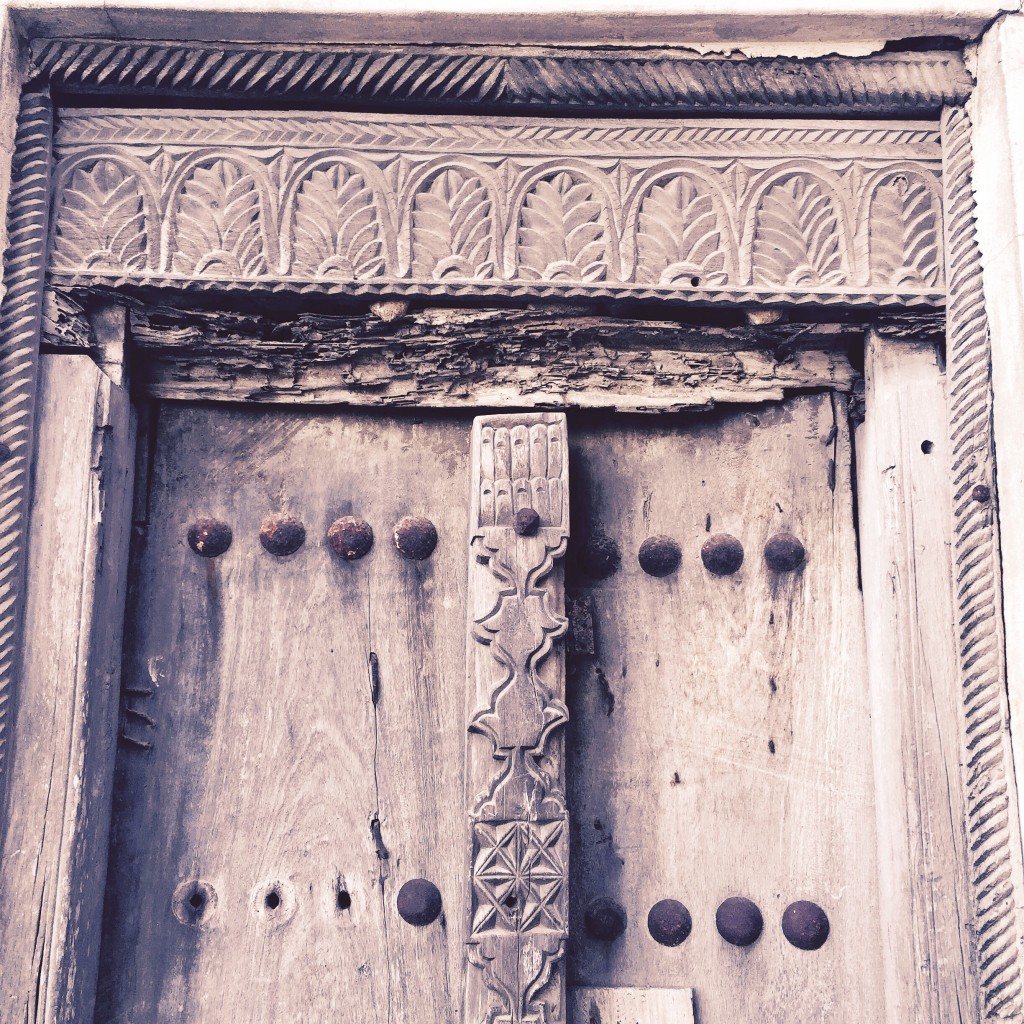The thing about Stonetown, Is you don’t realize you could know new flavors until you get here. Being here is like the sudden discovery of a new color; you think you already know every color you could see, it’s unimaginable to think about one day encountering a rainbow of all strange colors. Then you’re in Zanzibar: a place where your every sense is bombarded with strange and exotic sights, sounds, colors, scents, and tastes every second of every day.
We arrived here upon water so blue, it could have been poured from a billion Blue-Raspberry Gatorade bottles. The seashore was a strip of white sand, leading up to posh hotels of richness and mocktails on the beach. These we passed by instantly, choosing instead, to navigate the winding maze of allyways at the heart of Stonetown. Paved with dull-grey brick and cobble, and mirrored on both sides with intricately carved wooden doorways and stained walls, the narrow streets are the kind of adventure you go on to get lost. And we did, happily. On the first day here, I set out alone to find the bank: easily a five minute walk from the hostel if you know where to go, and traipsed past Mama’s selling coconuts and oranges and kitchy wazungu souvenir shops. I seized heartily upon familiar landmarks and backtracked with a blush when none could be found. Motorcycles zoomed freely around every corner; their warning bells ringing all over town, and street vendors sold chapatti (savory pan-fried dough) and beef skewers beside babas drinking chai (tea) who called out pleasantries to me as I backtracked past them three or four times. Finally, I arrived at the bank. Though a full half-hour into the adventure, I considered it a complete success, because though it took me a while to get there, I now knew EXACTLY how to get back (as well as how to get to some other pretty cool random places). The local market for instance is easily my favorite place in town. I have eaten nothing but street food for three days straight. Cooking food in front of your eyes, and far away from wazungu territory, the market is a chaotic jumble of fresh fruits frying chapatti, dried fish, date jam, and Zanzibarians everywhere. For dinner, a favorite of mine is a salad of sorts, made with savory doughnut holes, fried mashed potatoes, cassava (potato like tuber) and octopus. Served on a greasy sheet of newspaper and bathed in a pink spiced sauce. Zanzibari Halua, a date jam with sesame seeds, vanilla, cloves and all sorts of other spices (I can’t possibly name them all), is a sweet treat with chapatti for breakfast, and a freshly pressed glass of sugar cane with ginger and lime is a refreshing dessert. Stray cats wander about at your feet as you eat asking with big green eyes for scraps, and looking as cute as they can.
For centuries, Zanzibar has been a great East African trading center, and a crossroads of culture where Africa, India and Arabia meet. For ages Zanzibar was a slave port for all of East Africa. Africans rounded up across east Africa were funneled into Bagamoyo, a small coastal town near Zanzibar. Bagamoyo literally means “throw down your heart” a saying that described the slaves’ feelings as they saw the ocean for the first time, and realized they were leaving Africa. Almost all of East Africans passed through Stonetown on their way to a life of slavery in India and the Middle East.
Because of so much trade and cultural diffusion from Arabia and India, the population now is almost 99% Muslim, and while some tourists walk about in swim suits and mini-skirts, they are assuredly the only ones to do so. Most women float about adorned in flowing ankle-length gowns and head scarves of every color of the rainbow. As they drift past, they carry the sweet and spicy scent of Oud, a middle-eastern incense, and jasmine. Men can show their arms, but still wear embroidered, domed caps upon their heads and sometimes long white tunics, hitting past their knees.
While dress that would be appropriate in America is expected here and is somewhat accepted for tourists, it is in no way respectful of the people or the culture. There are so many people who don’t see enough when strolling these magical streets, and even more who choose not to see altogether. Their eyes skip over the people and see only the shops. They stay isolated in swanksville or on the beach and never experience having a real conversation with these people. They see what they want to see.
If I will take one thing out of my experience here, it is this: to assume the way you have lived until this moment is the same way all have lived, is to forfeit the experience of another person or place’s beauty.
It’s sad to witness one get so little out of a place with so much magic to give, although, as Simon and Alison always say: you get out of life what you put in.

